
British postcard in the Picturegoer Series, London, no. 27b.

Spanish collectors card by Chocolate Amatller, Series EE, artist 41, no. 83. Lewis Stone In The Prisoner of Zenda (Rex Ingram, 1922).
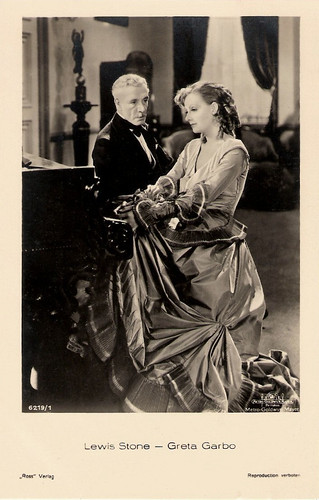
German postcard by Ross Verlag, no. 6219/1, 1931-1932. Photo: Metro-Goldwyn-Mayer (MGM). Greta Garbo and Lewis Stone in Romance (Clarence Brown, 1930).
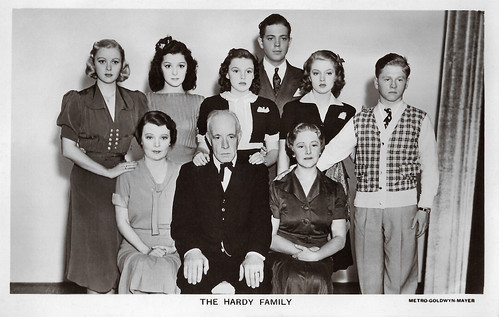
British postcard in the Picturegoer Series, London, no. 1280. Photo: Metro-Goldwyn-Mayer. Publicity still for Love Finds Andy Hardy (George B. Seitz, 1938) with (back row) Cecilia Parker, Ann Rutherford, Judy Garland, Gene Reynolds, Lana Turner, and (front row) Mary Howard, Lewis Stone, Fay Holden, and Mickey Rooney.
Two elegant and popular Swashbucklers
Lewis Shepard Stone was born in Worcester, Massachusetts, in 1879, to Bertrand Stone and Philena Heald Ball.
Reportedly, by age 20, Lewis's hair had turned gray prematurely. He served in the United States Army in the Spanish–American War as a lieutenant, then returned to a career as a writer.
He soon began acting. In 1912, he found success in the popular play 'Bird of Paradise' which starred Laurette Taylor. The play was later filmed in 1932 and 1951. Stone's career was interrupted by World War I where he served again in the United States Army in the cavalry as a major.
After the war, he went to China to train troops. After returning from China, he made his feature film debut either in The Man Who Found Out (Unkown director, 1915), according to IMDb or in Honor's Altar (Walter Edwards, 1916), according to Wikipedia.
Stone showed up in First National's Nomads of the North (David Hartford, 1920) as a Royal Canadian Mounted Policeman opposite Lon Chaney. He portrayed the title role in the silent film version of The Prisoner of Zenda (Rex Ingram, 1922) with Alice Terry and Ramon Novarro.
The three stars reunited for another elegant and popular Swashbuckler, Scaramouche (Rex Ingram, 1923). In 1924, Stone joined the newly-formed Metro-Goldwyn-Mayer where he remained for the rest of his career.
The next years, he was busy. He played an adventurer opposite Wallace Beery in the dinosaur epic The Lost World (Harry O'Hoyt, 1925), adapted from Arthur Conan Doyle's 1912 novel of the same name. The film featured pioneering stop motion special effects by Willis O'Brien, a forerunner of his work on the original King Kong.
Stone was nominated for the Academy Award for Best Actor in 1929 for The Patriot (Ernst Lubitsch, 1928). He played the character that gives the film its title, but he was not the top-billed star. That was Emil Jannings who starred as Emperor Paul I of Russia.
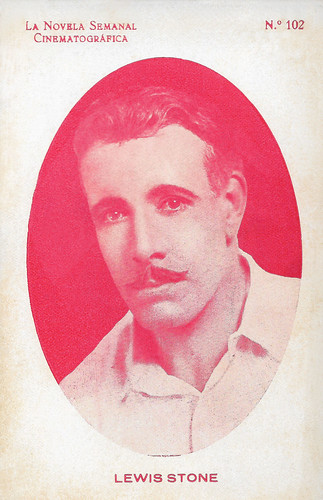
Spanish card by La Novela Semanal Cinematográfica, no. 102.

German postcard by Ross Verlag, Berlin, no. 679/2. Photo: Bafag. Alice Terry as Princess Flavia and Lewis Stone as King Rudolf in The Prisoner of Zenda (Rex Ingram, 1922).
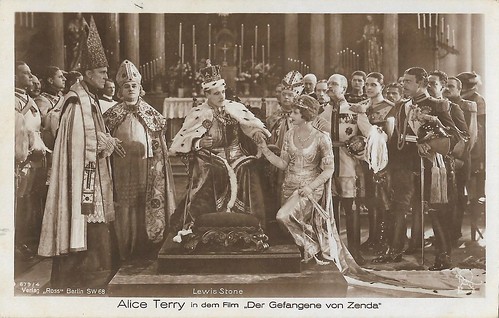
German postcard by Ross Verlag, no. 679/4. Lewis Stone as Rudolph Rassendyll and Alice Terry as Princess Flavia in The Prisoner of Zenda (Rex Ingram, 1922). The Bismarck-like guy behind Terry is the actor Robert Edeson, who plays Colonel Sapt. Behind him is actor Malcolm McGregor, who plays Captain Fritz von Tarlenheim. Both are the loyal aids of the King, defending him against his evil half-brother Michael (Stuart Holmes, who might be the man in black on the right) and his plotting cronies: his mistress Antoinette (Barbara la Marr) and Rupert von Hentzau (Ramon Novarro). Trying to stop a coup by Michael, who has abducted and imprisoned the real king, Sapt and Tarlenheim arrange a lookalike cousin of the king to be crowned (which we see on this card). The substitute king falls in love with Princess Flavia but he cannot tell the truth... Stone played both the King and his lookalike.
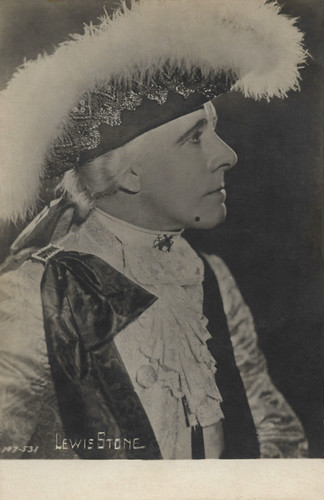
French postcard. Lewis Stone in Scaramouche (Rex Ingram, 1923).
Grand Hotel. People coming. Going. Nothing ever happens
Lewis Stone made the transition from silent to sound with The Trial of Mary Dugan (Bayard Veiller, 1929), which starred Norma Shearer. The sound film did not cause Lewis any problems and his appearance in the successful prison film The Big House (George Hill, 1930) furthered his career.
He continued to be busy with his roles as the distinguished lead and appeared in seven films with Greta Garbo, spanning both the silent and early sound periods. He played the role of Dr. Otternschlag in Grand Hotel (Edmund Goulding, 1932), in which he utters the famous closing line: "Grand Hotel. People coming. Going. Nothing ever happens."
The following year, he had a larger role in Queen Christina (Rouben Mamoulian, 1933). Stone also played an adventurer in The Mask of Fu Manchu (Charles Brabin, 1932) with Boris Karloff and a police captain in Bureau of Missing Persons (Roy Del Ruth, 1933) with Bette Davis.
In 1937, Stone essayed the role which would become his most famous, that of Judge James Hardy in the Andy Hardy series. Stone appeared as the judge in fourteen of the sixteen Andy Hardy features, beginning with You're Only Young Once (George B. Seitz, 1937).
Tony Fontana at IMDb: "Judge Hardy was the father audiences wanted in the late 30s early 40s. He was kind, intellectual, fair and as patient as he had to be with Andy, played by Mickey Rooney. This series occupied most of his screen time until it ended and he did slow down during the late 40s."
Stone also appeared in the short Andy Hardy's Dilemma, which promoted charitable donations to the Community Chest, but he had died by the time of the final Hardy feature, Andy Hardy Comes Home (Howard W. Koch, 1958).
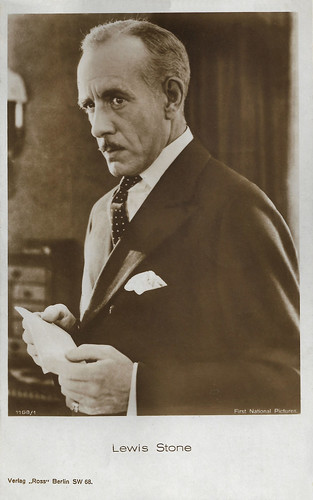
German postcard by Ross Verlag, Berlin, no. 1168/1, 1927-1928. Photo: First National Pictures.
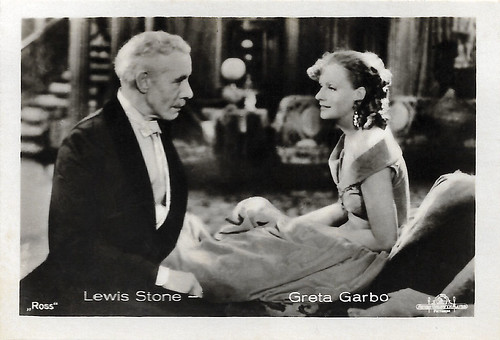
German collectors card by Ross Verlag for Filmalbum 4 'Aus Tönenden Filmen', Serie 4, no. 637, by A. Batschari Cigarettenfabrik, Baden-Baden. Photo: Metro-Goldwyn-Mayer. Greta Garbo and Lewis Stone in Romance (Clarence Brown, 1930).
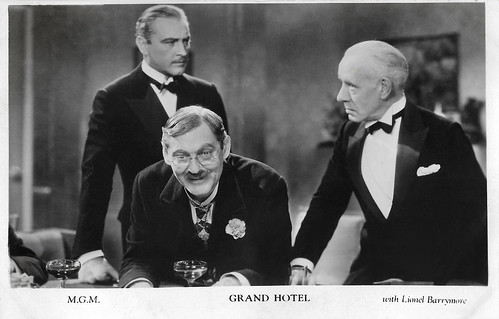
British postcard by Film Weekly. Photo: M.G.M. Lionel Barrymore, Lewis Stone, and John Barrymore in Grand Hotel (Edmund Goulding, 1932).
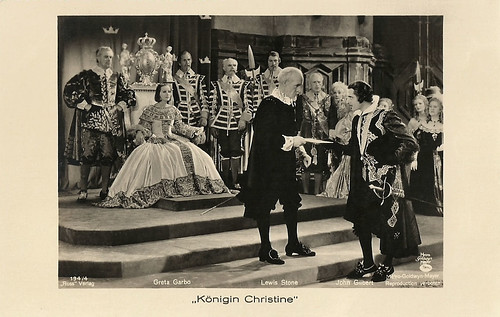
German postcard by Ross Verlag, no. 194/4. Photo: Metro-Goldwyn-Mayer. Greta Garbo, Lewis Stone and John Gilbert in Queen Christina (Rouben Mamoulian, 1933).
A heart attack while chasing away some neighborhood kids
During World War II, Lewis Stone was a lieutenant colonel in the California National Guard. Stone was MGM's longest-contracted actor and the longest-ever-contracted actor at a studio up to his death.
In the 1950s he continued to appear in a number of films including remakes of the two Swashbucklers he had made 30 years before with Alice Terry: Scaramouche (George Sidney, 1952), and The Prisoner of Zenda (Richard Thorpe, 1952), both starring Stewart Granger.
The week before his death, he (together with Lionel Barrymore) received a gold key to his dressing room. He had made approximately 100 films.
Lewis Stone died in Hancock Park, Los Angeles in 1953, aged 73. He reportedly suffered a heart attack while chasing away some neighborhood kids who were throwing rocks at his garage.
Another published report states that on that date Stone and his third wife were watching television when they heard a racket in the backyard. When he investigated, Stone found lawn furniture once again floating in the pool and glimpsed three or perhaps four teenage boys running towards the street. Stone gave chase despite his wife's warning not to exert himself. Upon reaching the sidewalk, Stone suddenly collapsed. A gardener, Juan Vergara, witnessed the chase and summoned aid.
A photo published in newspapers of the day showed Stone lying on the sidewalk immediately after the incident. Following his death, he was interred at Angelus Rosedale Cemetery in Los Angeles, California. He was married three times. His wives were Florence Oakley, Margaret Langham, and Hazel Elizabeth Wolf. With Oakley, he had two children. Lewis Stone was later honored with a star on the Hollywood Walk of Fame at 6524 Hollywood Blvd.

French postcard by Europe, no. 692. Photo: Metro-Goldwyn-Mayer.
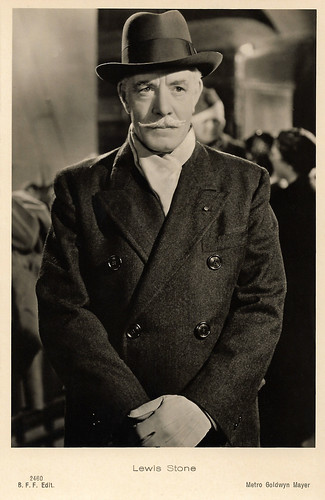
Italian postcard by B.F.F. Edit. (Casa Editr. Ballerini & Fratini, Firenze), no. 2460. Photo: Metro-Goldwyn-Mayer.

British postcard in the Picturegoer Series, London, no. 1346. Photo: Metro-Goldwyn-Mayer.
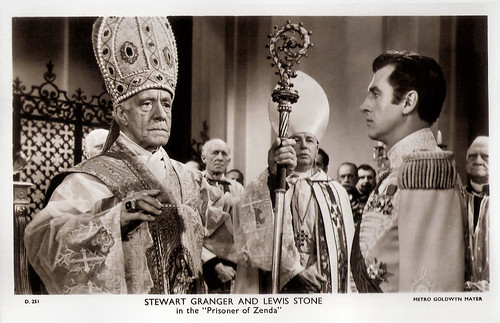
British postcard in the Picturegoer Series, London, no. D. 251. Photo: Metro-Goldwyn-Mayer. Stewart Granger and Lewis Stone (left) in The Prisoner of Zenda (Richard Thorpe, 1952).
Sources: Tony Fontana (IMDb), Wikipedia, and IMDb.
No comments:
Post a Comment